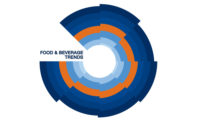2020 PREDICTIONS: FLAVOR & FOOD TRENDS
Welcome to the Future of Food
Liz Moskow partners with Spoonshot to predict food, beverage tastes, trends and consumer behaviors for 2021 and beyond

Despite its bad reputation as a 1970’s chocolate replacer, carob high in hydroxyproline is set to redefine its role to a collagen supportive ingredient for vegetarians.
PHOTO COURTESY OF: Chef Suzannah Gerber, The Plant-Based Gourmet
A leader on trends in the food industry, Liz Moskow has teamed up with Spoonshot, an emerging food intelligence platform to identify the leading-edge culinary trends that will impact menus, product development, and consumer behavior into 2022.
By leveraging Spoonshot’s massive data pool, Moskow, president of Bread & Circus, Denver, predicts trends before they happen, rather than highlighting them after trend adoption has begun.
Spoonshot analyzes billions of data points, across 22 different types of data, spanning more than 950 long-tail data sources. These include scientific journals, niche food communities, and social commerce platforms. Spoonshot connects seemingly disparate dots between these data sets using AI to uncover innovation opportunities. Given the huge volume of data examined and algorithmic connections made, Moskow can predict and interpret food trends empowered with new levels of organic intelligence.

Check out our December 2019 issue for more food & beverage predictions!
“Yearly trend lists, until now typically only reported on trends that have already passed the initial emergence stage and are already on mainstream and social media radars. By leveraging the AI technology of Spoonshot, food experts, such as myself, can predict the trends before they happen,” says Moskow. “This early prediction methodology makes it possible for Foodservice and CPG companies to get a jump on their innovation pipelines and develop and release products in a timelier manner to stay ahead of their competitors.”
Here are Moskow’s eight leading-edge culinary trend predictions.
Sugar Rush—The vilification of sugar is real! With continued mounting pressure from consumers to reduce product sugar content, CPG companies are rushing to find a new gold standard of sweetness. One thing trending is allulose, a sugar replacer derived from wheat and certain fruits. Thanks to the FDA’s decision to exclude allulose from total and added sugar declarations on nutritional facts panels, allulose is alluring to product developers. Taking a food tech approach, Nestlé and DouxMatok are focused on maximizing the efficiency of sugar to provide products with the same perceived sweetness but by using up to 40% less of it. Look for both allulose and sugar reduction technologies to trend into 2021 and beyond.
Garbanzo: Good to Great—The experimentation happening now with both chickpea flour and aquafaba (chickpea soaking water) is the springboard for future chickpea-based trends. Flatbreads and crusts made from chickpea flour will migrate from Italy and France onto American menus and into frozen food sections. Look for socca flatbreads and fainâ based pizzas to hit menus near you. Dairy-free ice cream, macarons, and meringues made with aquafaba will also take center stage into 2021 as consumers clamor for plant-based versions of their favorite sweets.
“No Bones” About it, Carob will Make a Comeback“—Despite its bad reputation as a 1970’s chocolate replacer, carob high in hydroxyproline is set to redefine its role to a collagen supportive ingredient for vegetarians. Look for it in coffee innovation, RTD beverage, baked goods, bars and powders.
Sexy-Ugly Flavor Mashups—Though you might at first turn your nose up at the thought of umami-rich seaweed paired with sweet caramel, or fish sauce and burned sugar, there are solid flavor pairing philosophies supporting these mash-ups. Consumers are starting to wrap their heads around the idea of flavor experience—it’s what makes accepted favorites like maple bacon doughnuts, apple pie with cheddar and Garrett’s Popcorn cheese and caramel mix so popular. We’ll start to see more experimentation with global umami and sweet into 2021.

Consumers want to reduce or eliminate sugar so continued research targets new sweetening options, technologies.
PHOTO COURTESY OF: THE COCA-COLA COMPANY (www.coca-cola.com)
CBD Adjacent—Copaiba, a completely legal essential oil derived from the resin of the Copaifera tree contains terpenes that interact with the endocannabinoid system in the body to purportedly provide similar therapeutic benefits to CBD. Added sparingly to elixirs and edibles, copaiba has a woodsy, sweet flavor and aroma conducive to relaxation. Look for copaiba to appear as an ingredient call-out beginning in the natural and organic space.
Climatarians are Coming!—Vegans have been doing their part to combat climate change by avoiding meat for years, but a more comprehensive approach is coming. This includes elimination of all foods with a high carbon footprint; such as meat and cheese, eating only locally grown and seasonal foods and avoiding products that exploit animals at risk from climate change. Foods to add to a climatarian diet would include algae, seaweed, pulses, grains and legumes, invasive species of plants, fish, and insects.
Fats Forward—Emerging research on good ol’ olive oil points to both Elenolide, a chemical component of olive oil that has proven anti-hypertensive properties as well as tyrosol, a compound that’s protective against neurodegenerative diseases. 2020 will see a return to the liberal use of extra-virgin olive oil as the favored fat and a move away from coconut oil.
Everything in Moderation—Recent food trends seem to exist at opposite ends of the healthy eating spectrum. From beefy burgers to plant-based patties, mezcal to mocktails, gold-flecked sundaes to medicinal mushroom coffee, consumers are vacillating between decadence and detoxification. 2020 will usher in a year of foodie bipartisanship where the path to the plate will be paved with more moderate choices.
Animal vs Plant—Reductitarians will win the day. Getting carnivores to permanently swap their meat for pea protein is not a winning proposition. More likely is a diet comprised of less meat rather than complete elimination. We’ll see a surge in products using the 50/50 method; substituting half the amount of meat for the plant; or half the dairy for nut milk.
Boozy vs Sober Curious—For the average American adult, imbibing with an alcoholic beverage often equates to being social and therefore isn’t going away anytime soon. Rather than choosing to regularly enjoy a boozy milkshake or a Japanese whisky highball, or abstaining altogether, beverages that employ a light and refreshing approach with lower ABV options will better appease the base.
Decadent vs Functional—From an entire bowl of edible cookie dough wrapped in rainbow cotton candy to a cheese sauce smothered five-pound burger, decadent, made- for- Instagram creations are on one side of the food spectrum. On the other, functionally formulated food and beverage products designed for wellness without much concern for flavor, texture or even efficacy... The moderate choice? Thoughtfully crafted food and beverage made with healthy ingredients in moderate portions with balanced flavor and efficacious amounts of beneficial ingredients.
Liz Moskow provides strategic thought leadership to food and beverage companies seeking product development, menu innovation, and holistic hospitality program integration. Reach her at Liz@breadandcircus.co.
Spoonshot equips the food and beverage industry with unprecedented foresight of emerging market needs. Spoonshot’s proprietary food science infused algorithms connect disparate data sets, to deliver personalized insights, predict trends, and identify novel opportunities. Visit www.spoonshot.com for more information.
Looking for a reprint of this article?
From high-res PDFs to custom plaques, order your copy today!





